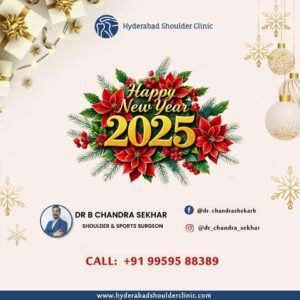Recurrent anterior shoulder dislocation primarily occurs due to initial injuries that compromise the integrity of structures stabilizing the shoulder joint. These structures include the labrum, ligaments, and the joint capsule. The primary cause often involves a traumatic event leading to an initial dislocation. This injury may stretch or tear these supportive structures, making them less effective in holding the humeral head (the top part of the arm bone) in the glenoid cavity (the socket in the shoulder blade).
After the initial dislocation, the shoulder is more prone to repeat dislocations because the ligaments have become stretched out or torn, and the labrum may be damaged, resulting in a Bankart lesion. Activities that involve overhead motions or forceful pulling on the arm can increase the risk of recurrent dislocations.
Moreover, younger individuals, especially those engaged in contact sports or activities that put the shoulder at risk, are more likely to experience recurrent anterior shoulder dislocations. The likelihood of recurrence diminishes with age, primarily due to decreased activity levels and natural stiffening of the shoulder joint’s soft tissues.

What does a patient experience if they have recurrent anterior shoulder dislocation?
The symptoms of recurrent anterior shoulder dislocation can vary in intensity from one person to another but typically include:
- Pain: This might be severe at the time of dislocation and persist as a dull ache long after the shoulder has been put back into place.
- Visible Deformity: The shoulder might appear out of position or visibly deformed compared to the non-affected side, especially immediately after the dislocation occurs.
- Limited Range of Motion: Difficulty moving the arm, especially in certain directions, or a complete inability to move it due to pain or weakness.
- Weakness: The shoulder may feel weak, making it difficult to perform regular activities, especially those requiring lifting the arm or bearing weight.
- Popping or Grinding Sensation: Some individuals might experience a sensation of the shoulder popping out or grinding, which can indicate the humeral head moving out of the socket.
- Swelling and Bruising: The affected area may swell and show bruising as a result of tissue damage and bleeding into the joint or surrounding tissues.
- Numbness or Tingling: In some cases, the dislocation can affect nerves around the shoulder, leading to numbness, tingling, or a pins-and-needles sensation in the arm, hand, or fingers.
- Instability: A general feeling that the shoulder could slide out of place again, particularly when attempting to move it into positions similar to when previous dislocations occurred. This perception of instability often leads to a reluctance to use the arm, further complicating recovery and rehabilitation.
It’s important to seek medical attention after a shoulder dislocation to assess the extent of the injury and receive appropriate treatment. Management of recurrent shoulder dislocations often involves a combination of physical therapy, strength training, and, in some cases, surgical intervention to restore stability to the joint and reduce the risk of further dislocations.
What are the recurrent anterior shoulder dislocation treatments?

Recurrent anterior shoulder dislocations can be a complex issue requiring a multi-faceted approach for effective management and treatment. Here are some common treatments and strategies to address this condition:
- Physical Therapy: This is often the first line of treatment. Physical therapy focuses on strengthening the rotator cuff muscles and improving the shoulder’s stability. Specific exercises can help tighten the shoulder muscles and ligaments, reducing the likelihood of dislocation.
- Immobilization: After a dislocation event, wearing a sling or another immobilization device for a short period can help the injured tissues heal properly. However, prolonged immobilization is generally avoided to prevent stiffness and weakness.
- Activity Modification: Avoiding activities or movements that increase the risk of dislocation is recommended, at least until the shoulder has gained sufficient strength and stability.
- Non-steroidal anti-inflammatory Drugs (NSAIDs): Medications can help manage pain and reduce inflammation during the acute phase following a dislocation.
- Surgical Intervention: In cases where non-surgical treatments have failed to prevent recurrent dislocations or if there is significant structural damage, surgery may be necessary. Surgical options include:
– Bankart Repair: This procedure is commonly performed to repair torn ligaments in the shoulder and is often done arthroscopically.
– Latarjet Procedure: If there is bone loss from the front of the glenoid (part of the shoulder blade), this procedure uses a piece of bone from another part of the body to repair the defect and stabilize the shoulder.
– Capsular Shift: This involves tightening the loose joint capsule around the shoulder to decrease the joint’s volume, which helps prevent dislocations.
- Proprioceptive Training: Enhancing the shoulder joint’s proprioception (sensory feedback) can improve its stability. Exercises that focus on balance and position awareness are beneficial.
Each patient’s situation is unique, and the best treatment plan depends on several factors, including the severity and frequency of dislocations, the patient’s age, activity level, and the presence of any associated injuries or conditions. Consulting with a healthcare provider specializing in sports medicine or orthopaedics is crucial to determining the most appropriate treatment strategy.
A word from Hyderabad Shoulder Clinics
Recurrent anterior shoulder dislocation can be a challenging condition that affects the stability and function of your shoulder joint. Recovery often involves a combination of rest, physical therapy, and sometimes surgical intervention to restore proper alignment and strengthen the shoulder muscles and ligaments. The focus is on strengthening the rotator cuff and improving shoulder stability to prevent future dislocations. It’s crucial to follow a tailored rehabilitation program under the guidance of a healthcare professional. Recovery time varies depending on the severity of the dislocation and the chosen treatment path, ranging from a few weeks to several months.
For more information, please visit our website https://hyderabadshoulderclinic.com/ or contact us at +91 9959588389 or shoulderandsportsclinic@gmail.com.





